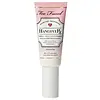What's inside
What's inside
 Key Ingredients
Key Ingredients

 Benefits
Benefits

 Concerns
Concerns

 Ingredients Side-by-side
Ingredients Side-by-side

Aloe Barbadensis Leaf Water
MaskingWater
Skin ConditioningGlycerin
HumectantAlcohol Denat.
AntimicrobialPEG-150 Distearate
EmulsifyingPolyglyceryl-10 Eicosanedioate/Tetradecanedioate
Skin ConditioningDiglycerin
HumectantCannabis Sativa Seed Extract
EmollientOpuntia Ficus-Indica Flower Extract
Skin ConditioningPrunus Avium Flower Extract
Skin ConditioningAgave Tequilana Leaf Extract
AstringentSodium Hyaluronate
HumectantNiacinamide
SmoothingSorbitol
HumectantPullulan
Inositol
HumectantBetaine
HumectantCarbomer
Emulsion StabilisingMaltose
MaskingXylitol
HumectantSodium Hydroxide
BufferingPvp
Emulsion StabilisingPropylene Glycol
HumectantPanthenol
Skin ConditioningVegetable Amino Acids
Skin ConditioningSodium Phytate
Citric Acid
BufferingAlcohol
AntimicrobialBenzoic Acid
MaskingSodium Benzoate
MaskingDehydroacetic Acid
PreservativeBenzyl Alcohol
PerfumingPotassium Sorbate
PreservativePhenoxyethanol
PreservativeAloe Barbadensis Leaf Water, Water, Glycerin, Alcohol Denat., PEG-150 Distearate, Polyglyceryl-10 Eicosanedioate/Tetradecanedioate, Diglycerin, Cannabis Sativa Seed Extract, Opuntia Ficus-Indica Flower Extract, Prunus Avium Flower Extract, Agave Tequilana Leaf Extract, Sodium Hyaluronate, Niacinamide, Sorbitol, Pullulan, Inositol, Betaine, Carbomer, Maltose, Xylitol, Sodium Hydroxide, Pvp, Propylene Glycol, Panthenol, Vegetable Amino Acids, Sodium Phytate, Citric Acid, Alcohol, Benzoic Acid, Sodium Benzoate, Dehydroacetic Acid, Benzyl Alcohol, Potassium Sorbate, Phenoxyethanol
Water
Skin ConditioningLactobacillus/Salix Alba Bark Ferment Filtrate
AntioxidantPropanediol Dicaprylate
EmollientPropanediol
SolventCeteareth-6 Olivate
EmulsifyingOlive Glycerides
EmulsifyingLactobacillus Ferment
Skin ConditioningAluminum Starch Octenylsuccinate
AbsorbentMicrocrystalline Cellulose
AbsorbentHydrogenated Olive Oil
Skin ConditioningPolyacrylate Crosspolymer-6
Emulsion StabilisingCellulose Gum
Emulsion StabilisingOlea Europaea Fruit Oil
MaskingPectin
Emulsion StabilisingTrisodium Ethylenediamine Disuccinate
Xanthan Gum
EmulsifyingOlea Europaea Oil Unsaponifiables
Skin ConditioningCocos Nucifera Fruit Juice
EmollientLauryl Alcohol Diphosphonic Acid
Emulsion StabilisingPentylene Glycol
Skin ConditioningGlycerin
HumectantLecithin
EmollientMagnesium Aluminum Silicate
AbsorbentParfum
MaskingLauric Acid
CleansingTocopherol
AntioxidantAscorbyl Palmitate
AntioxidantCitric Acid
BufferingWater, Lactobacillus/Salix Alba Bark Ferment Filtrate, Propanediol Dicaprylate, Propanediol, Ceteareth-6 Olivate, Olive Glycerides, Lactobacillus Ferment, Aluminum Starch Octenylsuccinate, Microcrystalline Cellulose, Hydrogenated Olive Oil, Polyacrylate Crosspolymer-6, Cellulose Gum, Olea Europaea Fruit Oil, Pectin, Trisodium Ethylenediamine Disuccinate, Xanthan Gum, Olea Europaea Oil Unsaponifiables, Cocos Nucifera Fruit Juice, Lauryl Alcohol Diphosphonic Acid, Pentylene Glycol, Glycerin, Lecithin, Magnesium Aluminum Silicate, Parfum, Lauric Acid, Tocopherol, Ascorbyl Palmitate, Citric Acid
 Reviews
Reviews

Alternatives
Ingredients Explained
These ingredients are found in both products.
Ingredients higher up in an ingredient list are typically present in a larger amount.
Citric Acid is an alpha hydroxy acid (AHA) naturally found in citrus fruits like oranges, lemons, and limes.
Like other AHAs, citric acid can exfoliate skin by breaking down the bonds that hold dead skin cells together. This helps reveal smoother and brighter skin underneath.
However, this exfoliating effect only happens at high concentrations (20%) which can be hard to find in cosmetic products.
Due to this, citric acid is usually included in small amounts as a pH adjuster. This helps keep products slightly more acidic and compatible with skin's natural pH.
In skincare formulas, citric acid can:
While it can provide some skin benefits, research shows lactic acid and glycolic acid are generally more effective and less irritating exfoliants.
Most citric acid used in skincare today is made by fermenting sugars (usually from molasses). This synthetic version is identical to the natural citrus form but easier to stabilize and use in formulations.
Read more about some other popular AHA's here:
Learn more about Citric AcidGlycerin is already naturally found in your skin. It helps moisturize and protect your skin.
A study from 2016 found glycerin to be more effective as a humectant than AHAs and hyaluronic acid.
As a humectant, it helps the skin stay hydrated by pulling moisture to your skin. The low molecular weight of glycerin allows it to pull moisture into the deeper layers of your skin.
Hydrated skin improves your skin barrier; Your skin barrier helps protect against irritants and bacteria.
Glycerin has also been found to have antimicrobial and antiviral properties. Due to these properties, glycerin is often used in wound and burn treatments.
In cosmetics, glycerin is usually derived from plants such as soybean or palm. However, it can also be sourced from animals, such as tallow or animal fat.
This ingredient is organic, colorless, odorless, and non-toxic.
Glycerin is the name for this ingredient in American English. British English uses Glycerol/Glycerine.
Learn more about GlycerinWater. It's the most common cosmetic ingredient of all. You'll usually see it at the top of ingredient lists, meaning that it makes up the largest part of the product.
So why is it so popular? Water most often acts as a solvent - this means that it helps dissolve other ingredients into the formulation.
You'll also recognize water as that liquid we all need to stay alive. If you see this, drink a glass of water. Stay hydrated!
Learn more about Water